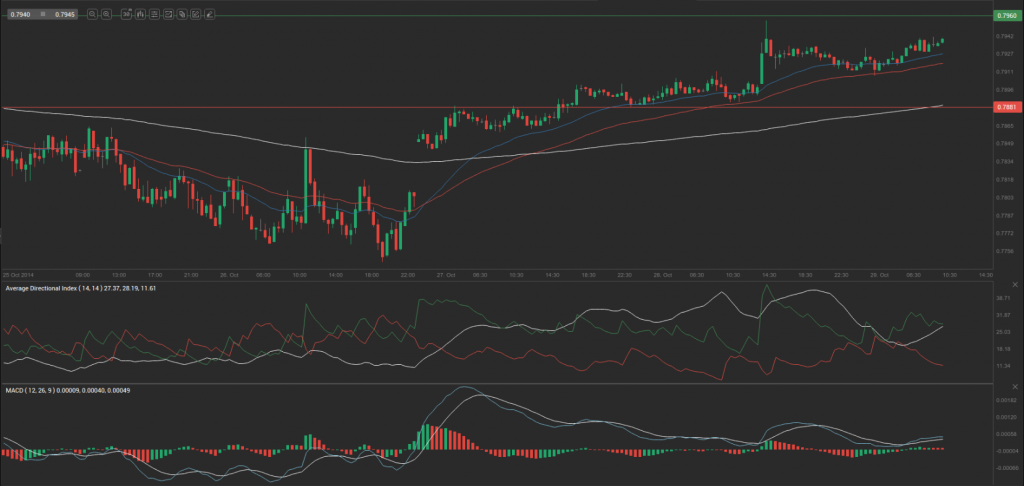 Yesterday’s trade saw NZD/USD within the range of 0.7881-0.7960. The pair closed at 0.7920, gaining 0.33% on a daily basis.
Yesterday’s trade saw NZD/USD within the range of 0.7881-0.7960. The pair closed at 0.7920, gaining 0.33% on a daily basis.
At 8:36 GMT today NZD/USD was up 0.30% for the day to trade at 0.7941. The pair touched a daily high at 0.7944 at 8:30 GMT.
Fundamentals
New Zealand
RBNZ policy decision
Reserve Bank of New Zealand (RBNZ) will probably leave its benchmark interest rate (the official cash rate) without change at 3.50% at the policy meeting today, according to expectations. The central bank raised borrowing costs by 25 basis points (0.25%) to the current 3.50% at the July 23rd meeting, which marked the fourth consecutive increase in rates this year.
In September the central bank left borrowing costs intact, in order to better assess the moderating effects of the recent policy tightening and export price reductions. According to extracts from the statement, taken by RBNZ Governor, Graeme Wheeler, following the banks most recent policy decision: ”New Zealand’s economy is expected to grow at an annual pace of 3.7 percent over 2014. Global financial conditions remain very accommodative and are reflected in low interest rates, narrow risk spreads, and low volatility across a range of asset markets. Accommodative financial conditions are supporting a moderate rate of global growth, albeit uneven across regions.
The exchange rate has yet to adjust materially to the lower commodity prices. Its current level remains unjustified and unsustainable. We expect a further significant depreciation, which should be reinforced as monetary policy in the US begins to normalise.
The economy appears to be adjusting to the policy measures taken by the Bank over the past year. House price inflation continues to ease, despite strong net immigration. CPI inflation remains moderate, reflecting subdued wage increases, well-anchored inflation expectations, weak global inflation, and the high New Zealand dollar. However, spare capacity is being absorbed, and annual non-tradables inflation is expected to increase. Risks also remain around how strongly net immigration will affect housing demand, and the extent to which pressures in the construction sector will impact broader inflation.
In light of these uncertainties, and in order to better assess the moderating effects of the recent policy tightening and export price reductions, it is prudent to undertake a period of monitoring and assessment before considering further policy adjustment. Nevertheless, we expect some further policy tightening will be necessary to keep future average inflation near the 2 percent target mid-point and ensure that the economic expansion can be sustained.”
Short-term interest rates are of utmost importance for the valuation of national currencies. In case the Reserve Bank of New Zealand is hawkish about inflationary pressure in economy and, thus, decides to introduce another rate hike, this would certainly provide a boost to the kiwi dollar.
The official decision on policy is expected at 20:00 GMT.
United States
FOMC policy decision
The Federal Open Market Committee (FOMC) will probably keep its benchmark interest rate unchanged within the range 0-0.25% for a 46th consecutive meeting. In addition, the FOMC members will probably reduce the pace of monthly asset purchases by $15 billion to exit the Quantitative Easing cycle, according to the median forecast by experts.
The minutes of Federal Open Market Committee meeting, conducted in September, revealed that policymakers expressed concerns over recent appreciation of the US dollar and the effects it might have on economic growth and inflation. According to extracts from the minutes: ”During participants discussion of prospects for economic activity abroad, they commented on a number of uncertainties and risks attending the outlook. Over the intermeeting period, the foreign exchange value of the dollar had appreciated, particularly against the euro, the yen, and the pound sterling. Some participants expressed concern that the persistent shortfall of economic growth and inflation in the euro area could lead to a further appreciation of the dollar and have adverse effects on the U.S. external sector. Several participants added that slower economic growth in China or Japan or unanticipated events in the Middle East or Ukraine might pose a similar risk. At the same time, a couple of participants pointed out that the appreciation of the dollar might also tend to slow the gradual increase in inflation toward the FOMCs 2 percent goal.
In their discussion of the appropriate path for monetary policy over the medium term, meeting participants agreed that the timing of the first increase in the federal funds rate and the appropriate path of the policy rate thereafter would depend on incoming economic data and their implications for the outlook. That said, several participants thought that the current forward guidance regarding the federal funds rate suggested a longer period before liftoff, and perhaps also a more gradual increase in the federal funds rate thereafter, than they believed was likely to be appropriate given economic and financial conditions.”
Massive bond purchases tend to pressure longer-term interest rates and also devalue the national currency. Scaling back these purchases has the opposite effect on the dollar. Therefore, in case the central bank’s policy makers cut the monthly asset purchases, this would certainly bolster demand for the greenback. The FOMC will announce its official decision on policy at 18:00 GMT.
Pivot Points
According to Binary Tribune’s daily analysis, the central pivot point for the pair is at 0.7920. In case NZD/USD manages to breach the first resistance level at 0.7960, it will probably continue up to test 0.7999. In case the second key resistance is broken, the pair will probably attempt to advance to 0.8039.
If NZD/USD manages to breach the first key support at 0.7881, it will probably continue to slide and test 0.7841. With this second key support broken, the movement to the downside will probably continue to 0.7802.
The mid-Pivot levels for today are as follows: M1 – 0.7822, M2 – 0.7861, M3 – 0.7901, M4 – 0.7940, M5 – 0.7980, M6 – 0.8019.
In weekly terms, the central pivot point is at 0.7896. The three key resistance levels are as follows: R1 – 0.8000, R2 – 0.8145, R3 – 0.8249. The three key support levels are: S1 – 0.7751, S2 – 0.7647, S3 – 0.7502.






